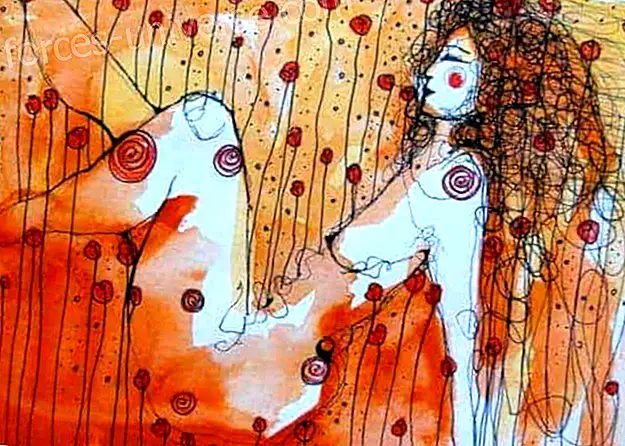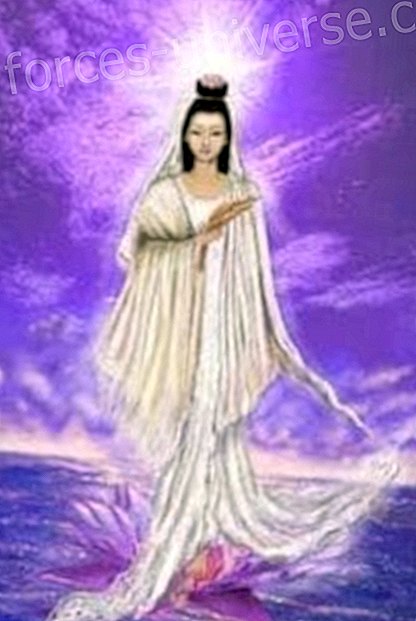
The ancient Greeks believed that music modeled the personality of individuals. In Egyptian temples, this is an essential part of their magical rites, starting with altering the course of Nature or treating diseases. And today it is known that in effect, sound is capable of modifying matter. The secret keys of music lie in harmony and mathematics, and many of the great musicians and initiates of all time have been aware of this.
The natives soon appeared. Tidily, they were distributed forming two concentric triangles in a field and in the center they placed a tent decorated with brightly colored drawings. Strangely, they didn't fix it to the ground. Meanwhile, a group of richly dressed musicians took positions alongside the formation of indigenous people and began to beat their drums rhythmically.
Mrs. Margaret A. Bevan was stunned. He had traveled to Canada in 1939 to witness that ceremony, and had obtained permission to follow it from the inner triangle. What I could never have imagined is that the store was going to start shaking and rising above the ground. First it ascended about four meters high, then descend and return to its initial position. But as the rhythm of the drums accelerated, the store again lost weight and ascended. In the open, there was a small fire that gave off an aromatic smell similar to incense.
And it didn't end there. Mrs. Bevan also observed how musicians suddenly changed their rhythm. When the new sound spread across the plain, the store flew a third time, although the misty silhouette of an athletic Indian dressed in white robes became visible on the ground. A spirit? When the store descended for the last time, that image vanished ...
This story, published in September of that same year by the British magazine Psychic News is, although surprising, one more of the countless stories that throughout history refer to the extraordinary power of music. Cases similar to this one are cited by travelers, writers and occultists like Helena Blavatsky, who picked them up in her Secret Doctrine. And, in some places like Tibet, there are legends of initiates in the “sacred science” of mantras, which apparently could be used to transport huge rock masses when singing certain sounds. It is not even missing those who have theorized that the cyclopean European megalithic constructions, the pyramids of Egypt or the statues of Easter Island, were moved thanks to the help of magical songs, words of power or dances that had the power to lighten the solid matter. Now, what basis exists for these types of stories? And since when do they circulate?
The ancient Greeks already understood the importance that music had in the balanced development of the individual. Plato, for example, considered it essential that the state monitor the type of music that was performed in theaters and schools since, in his opinion, there was a great affinity between the music heard and the personality of the individuals. He never said that music would model stones but that he forged characters. He also affirmed that the influence of certain rhythms and melodies caused a beneficial state of mind, hardly available by other means. Aristotle, on the other hand, said that "it is impossible to deny the ethical power of music and, consequently, the need for it to be part of the instruction of childhood."
But the Greeks were not content to expose their theories, but instead established a correspondence between the musical scales (called "modes") and the different moods of the people. In this way, they established that the so-called lidio mode had a solemn character and should be interpreted in the mourning ceremonies; the Phrygian balanced the psychic faculties; the Ionian was festive and accompanied the celebrations, while the Doric raised the warlike spirit of the soldiers. Pythagoras went even further.
The influence of Pythagorean theories was decisive in at least four plots of knowledge: philosophy, mathematics, physics and the occult. For the Pythagoreans, all matter contained in space could be mathematically quantifiable, and since the very principle of mathematics resided in numbers, they established that these were the very essence of the Universe. They affirmed that, since the figures are of two types - even and odd - reality could be defined dually as the opposition between opposites, the balance between the two being what they called Harmony. And this, applied to the field of acoustics, was equivalent to the sympathetic relationship between the different sound intervals.
They believed so much in this principle that they spent a lot of time identifying the intervals, studying their magical properties and applying them to their instruments. Thus, thanks to the help of a “sonometer” (a box containing a tense string inside) they formulated the Law of string length, which enabled, for the first time, the mathematical knowledge of the tuning of the musical scale.
The ambitious vision of Pythagoras did not stop, however, in the intonation of melodies. He taught his disciples to cure diseases through sounds, and showed them the relationship that existed between the beauty of geometric shapes, stars, colors and musical notes. According to Porfirio, one of his biographers, Pythagoras considered the cosmos as a set of analogies and invisible proportions, firmly balanced among themselves. I thought that, just as "cosmic music" spreads through the ether and balances the Universe, similarly the music composed by the artists should be disseminated. His "music of the spheres" was not only an idealistic speculation, but a true physical reality.
Unfortunately, after his death this genius was highly criticized. Christianity was not interested in the belief of the Pythagoreans in reincarnation and the immortality of the soul spread and chose to assimilate Platonic thinking, much more adaptable to their ideology. The inheritance of the Pythagoreans, however, was later collected by groups of initiates that would be organized into Masonic lodges, Rosicrucian fraternities, theosophical societies and other occult movements.
Let's not fool ourselves: Pythagoras not only discovered the famous theorem that bears his name. Thanks to him, music therapy, the tuning of musical intervals and the magic proportions between stars and sounds were also known. Of all the proportions discovered by the Pythagoreans, the so-called "golden section" or "divine" was the main one. This division, which the Babylonians already knew and that the wise man of Samos would learn during his more than twenty years of study with Egyptian priests, is obtained when a line is cut in two parts, the proportion between the minor and the major segment being equal. than that of the larger segment with respect to the total line.
For the Pythagoreans this proportion was present in all manifestations of nature and was also part of geometric figures that they considered sacred, such as the pentacle or the dodecahedron. Indeed: if we examine a pentacle, we will see that each of its sides is based on the idea of "golden section." Similarly, the pentagon contains a pentacle on each side, and it is based on pentagons as the dodecahedron is also constructed. Five is also the number that qualifies one of the most important sound intervals, the fifth or diapente. And from there derives the idea of the musical pentagram ...
According to Luciano, the pentagram was the secret password of the Pythagoreans. Although their detractors branded them as sectarian crazies, the truth is that the "golden section" on which it was based triumphed among sculptors like Polícleto or geniuses like Leonardo, who made the "golden section" the basis of their "canon ”, Managing to seduce later authors such as Descartes, Skakespeare or Kepler. Thus, both the fifth musical interval, which is an essential element of the current tonal system, and the “golden section”, which frequently appears in the ternary structure of some musical forms, denote the imperishable influence of the Pythagoreans in western music .
In medieval esotericism, the number seven amounted to the entire Universe. The seven sounds of the scale were related to colors, it was a powerful key to introduce the initiated into the mysteries of magic. The theories of Plato and Pythagoras, which related the balance of musical proportions with mood, extended during that time in architecture, and the golden ratio was reflected in many buildings. Medieval artists were very aware of the correspondence between the different arts, and it was very frequent that musical, architectural and pictorial approaches related to each other. Anyway, it would be a mistake to seek, without sufficient knowledge of cause, numerical or esoteric relationships in each religious building. Without a doubt, there is a correspondence in the external structure of both artistic manifestations, but it would be rash to affirm that each cathedral is the static version of a musical composition. Works as valuable as those of Marius Schneider, who thought he discovered that the arrangement of the figures of the capitals of the cloister of San Cugat del Vall s (Barcelona) almost exactly represents a religious hymn of the eleventh century dedicated to San Cucufate, they must be examined with the consequent reservations.
Many more documented are the cases of altered consciousness produced in mystics and religious due to certain melodies. At this time of asceticism and eccentric visions phenomena happened like the `` apparitions with sounds '' in which a spiritual entity manifested itself accompanied by certain sonorities. Or also the celestial music, which was supposed to be announced by spirits that, according to the Christian conception, were angels; the, in which one or several voices manifested spontaneously before one or more people, are some of the phenomena experienced by some characters of the time.
A well-known case of Ä ÄÄÄÄÄÄÄÄÄÄÄÄÄÄÄÄÄÄÄÄG hymn O Vernantes Christi Rosae, thanks to the huge choir of the maidens singing from there from there the melody while he transcribed it. Richard Rolle (1300-1349), on the other hand, was an Eremite poet and visionary who listened to the singing of the angels while suffering a significant change in body temperature. The best known are the phenomena starring the Benedictine Hildegarda von Bingen (1098-1179) who frequently entered into states of rapture in which he listened to music sung by the angels. He even wrote texts in an unknown language that, according to what he said, was dictated to him by a celestial spirit. These writings, which constitute one of the most genuine examples of xenoglossia, still await a serious philological study that sheds some light on their meaning.
In the Renaissance, the relationship between music and occultism narrows, since both alchemy and magic were activities that the brightest minds of the time practiced regularly. The documents that have reached us offer no doubt about the hidden knowledge that some alchemists had about music and its power. On the other hand, the emergence of Rosicrucianism and Freemasonry constituted a capital fact in the development of the study of the magical properties of sound, since it re-injected ideas. Pythagorean
Although there was an old medieval tradition that already mentioned the rose in romances that related to alchemy and hermeticism, it was not until the appearance of the writings attributed to Valentin Andreade (1586-1684 ) when there was serious talk about the existence of a community of mysterious characters called Rosicrucians. Of the different texts that appeared about the `` brothers '', three were those who, after their edition at the beginning of the 17th century, established the theoretical base on which the movement was based: the Confessio, Fame Fraternitatis and The chemical weddings of Christian Rosenkreutz .. Robert Fludd (1574-1637), a physician and physicist who professed Rosicrucian philosophy, was one of the most prominent figures of Renaissance thought. Being faithful to the hermetic paradigm that establishes “what is above is below”, Fludd considered the human being as a scale reduction, like a microcosm, of the great celestial macrocosm that surrounds us. A great connoisseur of mathematics and cabal, he managed to synthesize both disciplines in a kind of "mystical" Pythagoreanism. His ideas, too influenced by the occult, came into confrontation with some of the scientific advances of his time, especially when he defended the geocentric conception of the solar system against the heliocentrism of Johannes Kepler.
In his early 17th century work, Utrisque Majoris et Minoris Historia, Fludd proposes a correspondence between human proportions and those of the Universe through music. For Fludd, music is a compendium of numerology that governs the Cosmos, balancing it through the harmony of the souls that God governs. According to him, the harmony of the soul would be formed by high-pitched sounds that would progressively become so subtle that they could not be perceived by the human ear. This vibration inaudible to mere mortals would be the same "cosmic music" that Pythagoras referred to.
Another alchemist, Michael Maier (1568-1631), knew how to synthesize in his book The Fugue of Atalanta (1618), the speculations of his friend and co-frater Fludd, although while English was expressed philosophically, Maier would prefer to do it through beautiful allegorical engravings. In this way, each of the steps that led to the realization of the alchemical “Great Work” was illustrated by a magnificent image of a hermetic nature, by a short poem and by a two-voice musical composition with continuous bass accompaniment. Atalanta music, consisting of different canons or melodies that are imitated, was performed in London in 1935, under the supervision of musicologist Sawyer. Maier thus masterfully embodied, with music and allegories, the Rosicrucian concept of equivalence between the macrocosm and the microcosm. In those days, alchemy and music were considered "Great Art" and the creation process that consolidated them was called "Great Work." The alchemists also referred to the "philosopher's stone" as "musical stone, " considering it an allegory of knowledge of the arts and sciences.
In addition to Maier's work, there are also clear musical allusions in the works of other casters such as Heinrich Khunrath (1560-?), Which presents a table full of musical instruments in one of the engravings of his Amphitheatrum Sapientae Aeternae, or Barchusen, which includes the image of a choir of angels in the frontispiece of an engraving of the Museum Hermeticum. Other musical references are contained in Las Bodas Químicas and Cristianópolis (1619), both of the aforementioned Andreade. But the Rosicrucian musical tradition, one of the richest in hidden history, would not end here.
DM Gonzalez de la Rubia.






